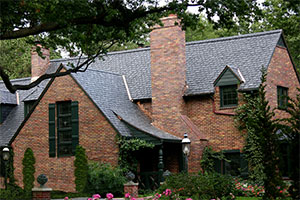Roofing 101: What Should You Put on Your Home?
by Kathy Ziprik, Staff Writer
When building a new home, a roof is a major investment. It's not just the tiles that help protect your house and its contents—the roof also plays a key role in the curb appeal of your home. Since most people don't purchase a roof as often as they would appliances, or even as often as they might replace windows or doors, it's important that extra time and consideration be given to a roofing selection.
“Thoroughly researching roofing options should be a priority for any homeowner considering a new roof,” says Tim Gentry, vice president of technical services at DaVinci Roofscapes. “Many aspects should be considered, including a product’s warranty, style and durability. A homeowner should ask the question ‘what will this roof do for me?’ before making a decision.”
According to Gentry, who served 20 years as a roofing installer and has been in the industry for more than 40 years, a roof should be carefully selected to complement a home’s design and geographic weather conditions. It should also provide long-term comfort and safety for those who live in the home. We've gathered some of the most frequent questions Gentry receives from homeowners nationwide, and provided answers so you can make an informed decision.

What are the pros and cons of different roofing materials?
Three-tab asphalt shingles are relatively easy to install, inexpensive and look good on ordinary homes. However, they can be a poor environmental choice because they go to a landfill after 20 years. Additionally, they perform only moderately well, and they don’t add any special design appeal to a home.
Real wood shingles or shakes look good on some styles of homes and are moderately priced, but they have little or no resistance to fire or impact unless specially treated. They also attract insects, have relatively poor long-term performance and are generally considered a poor use of our natural resources. And, in some areas of the country, real wood shakes are now prohibited by local laws due to their susceptibility to flame spread.
Real slate shingles also provide a good look on some styles of homes and can be considered very long-lasting when installed properly. However, they are very expensive and extremely heavy. During installation you can have a significant amount of waste from cracking and breaking of slate tiles.
Metal roofs are perfect for some very specific home designs. They have a unique look to them, are lightweight and snow can easily slide off of them. Watch out when it rains or hails though—these roofs are noisy on the inside of the home during storms.
Synthetic roofing tiles provide a high-performance option for homeowners. The tiles come in a variety of styles, including slate and shake, are lightweight and have long-term durability. These tiles are a good aesthetic choice for the home, and since they can be recycled, they're also a good environmental choice. While the look complements many home styles, synthetic roofing tiles are also moderately priced, so they’re affordable for everyone.
With the look of natural wood shingles, but without the flammability of the real thing, these
Bellaforté Shakes provide a safe alternative for homes that just look better with shingle roofing.

What are the life spans of different roofing materials?
Generally, real wood will wear out the fastest, followed by three-tab asphalt shingles. You can maybe get 15-20 years out of each of these. Some metal roofs can last up to 50 years, depending on their warranty. Synthetic roofing tiles (sometimes called composite or polymer tiles) can last more than 50 years depending on the manufacturer, and they require minimal maintenance attention. Real slate also lasts many years on a home—sometimes up to 100 years!
Why would I consider synthetic roofing materials over traditional asphalt products?
Aesthetics and durability. Typical asphalt shingles look ordinary. Consider this: when you look at many homes, especially those with steep roofs, almost half of what you see is the roof. When selecting a roof, think about curb appeal and resale value. Synthetic tiles make an ordinary home look extraordinary. Additionally, they give the homeowner peace-of-mind because these roofing tiles will perform exceptionally well against fire, impact, wind and other weather conditions.
What is synthetic roofing material made of?
At DaVinci Roofscapes, we use an engineered polymer, which is impregnated with fire retardant and state-of-the-art advanced ultraviolet (UV) stabilizers specifically formulated for the tough conditions tiles are exposed to in all climates throughout the year. Our roof tiles use virgin resin in order to assure consistency, and are 100% recyclable.
Do roofing tiles become more brittle over time?
That depends on the kind of roofing tiles. Asphalt and real wood roofing materials do become more brittle toward the end of their life cycles. DaVinci tiles do not have that problem. The engineered polymer used in DaVinci synthetic tiles changes very little over time or when subjected to extreme temperature and weather conditions. Third party independent extended life testing has shown minimal degradation of the material’s performance qualities.
Which roofing tiles are consistent with their colors and won’t fade over time?
Most synthetic roofing tiles have their color blended completely throughout. These products won’t fade over time because UV protection has been built into each tile. When exposed to continual sunlight and UV rays, many other products, such as metal and asphalt roofing, will indeed fade over time, losing their original sharpness of color.



.png)
.png)



